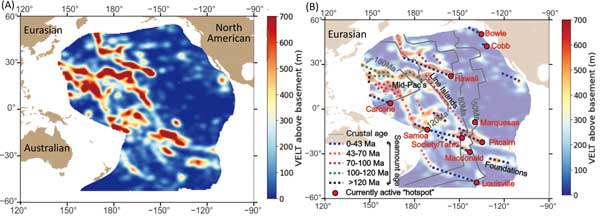 |
How strongly do plumes influence Pacific seamount distribution?
|
Yanghui Zhao1, Bryan Riel2, Gillian R. Foulger3,4, & Weiwei Ding1
1Key Laboratory of Submarine Geosciences, Second Institute of Oceanography, Ministry of Natural Resources, Hangzhou 310012, China; zhaoyh@sio.org.cn; wwding@sio.org.cn
2School of Earth Sciences, Zhejiang University, Hangzhosu 310027, China; briel@zju.edu.cn
3Department of Earth Sciences, Durham University, Durham DH1 3LE, UK; g.r.foulger@durham.ac.uk
4Institute of Marine Geodynamics, College of Marine Geosciences, Ocean University of China, Qingdao 266100, China; gillianrosefoulger@ouc.edu.cn
This webpage is a summary of: Yanghui Zhao, Bryan Riel, Gillian Foulger and Weiwei Ding. How strongly do plumes influence Pacific seamount distribution? Earth and Planetary Science Letters, Volume 595, 2022, 117786, https://doi.org/10.1016/j.epsl.2022.117786.
Seamounts are submarine volcanoes postulated to be formed either from magma that rose from the deep mantle via hot plumes or from the lithosphere and asthenosphere. It is widely believed that plumes bring material from the lowermost mantle to the surface where it melts by decompression. Plumes are considered by many to dominate whole-mantle convection and give rise to the majority of the volcanism within plate interiors. However, the relative importance of postulated plume-contributed volcanism remains poorly constrained due to difficulties associated with quantification of seamount volume, an established metric for the volume of erupted melt.
We apply Tophat filtering and Gaussian Process regression to publicly available bathymetry data. We update the seamount volume distribution by following the exposed, irregular seamount topography above the seafloor and additionally extrapolating the buried seamount topography under the sedimentary layer. The results show that the volume of seamounts in the Pacific plate has been underestimated by 75% in previous work as a result of neglecting irregular seamount shapes and sediment blanketing of the lower slopes.
Following Conrad et al. (2017), we map the spatial distribution of seamount volume on the Pacific plate by calculating a volcanic equivalent layer thickness (VELT) using a moving window of 300 × 300 km (Figure 1). High values of VELT are associated both with chains widely attributed to plumes (e.g., Hawaii and Samoa) and to chains commonly attributed to non-plume processes (e.g., the Tokelau chain, the Gilbert chain, the Line islands and scattered seamounts on the oldest crust).

Figure 1. (A) VELT above basement quantified using Gaussian Process regression to reconstruct seamount topography under the sedimentary layer and compute the spatial distribution of seamount volume. (B) Seamount chains with age information (Koppers et al., 2003) and proposed currently active “hotspots” on the Pacific plate from the list of Courtillot et al. (2003). Background is VELT above the basaltic basement. Click here or on Figure for enlargement.
The spatial distribution of VELT expresses the supply of melt to Earth's surface. Our results show volcanism proposed to be plume-associated only contributes 18% of the volume of total intraplate volcanism. Of all proposed plumes in the Pacific plate, Courtillot et al. (2003) consider only Hawaii and Louisville to originate from the lowermost mantle. Other studies have contested this and reject the plume hypothesis entirely (Anderson et al., 2014). Our estimated plume VELT represents an upper bound of the erupted volume attributed to the most widely accepted plumes.
Proposed plume-contributed volcanics exhibit similar volume-time statistical properties to the majority of the seamounts (Figure 2). Regarding the distribution of the seamounts, neither “hotspot” seamounts nor those along the Large Low-Shear-Velocity Province (LLSVP) margins are significantly different in this respect from the rest (also the majority) of the seamounts.
Using different plume lists gives very similar results. Overall, proposed plume-related seamounts are mainly concentrated on mid-aged seafloor (90-120 Ma) except for the seamount volume distribution that excludes Hawaii (Figure 2B). That is to say, only the Hawaiian seamounts have large enough volumes to significantly change the time distribution of proposed-plume-related volcanism in the Pacific plate. Thus, in this respect, proposed-plume volcanism volume in the Pacific plate is heavily dependent on Hawaii alone.
Similar work by Conrad et al. (2017) proposed that intraplate volcanism is sourced from asthenospheric melts while some local areas with higher volcanism, such as the older Pacific, might require additional melts from the deep mantle. Our accurate mapping of seamount volcanism further clarifies that these postulated additional melts from the deep mantle account for at most 18% of total intraplate volcanism in the Pacific plate. Our results therefore indicate that plume processes do not dominate Pacific intraplate volcanism, the majority of which is likely related to non-plume processes.

Figure 2: Comparison of VELT above the basaltic basement for four categories of seamounts. (A) VELT as a function of seafloor age. Shaded regions indicate an uncertainty of 0.5-σ. Catagories (Cats.) 1-3 change synchronously where seafloor ages are <140 Ma. Plume-related volcanism accounts for a small fraction of the total where seafloor ages are <140 Ma. (B) Comparisons of VELT for different plume lists as a function of seafloor age. Proposed plume-related seamounts are mainly concentrated on mid-aged seafloor (90-120 Ma) associated with Hawaii. Cat. 1, all seamounts; Cat. 2, non-hotspot (non-plume-related) seamounts; Cat. 3, hotspot (plume-related) seamounts; Cat. 4, all seamounts above the LLSVP margin.
References
- Anderson, D.L., Natland, J.H., Ernst, W.G., 2014. Mantle updrafts and mechanisms of oceanic volcanism. Proc. Natl. Acad. Sci. U. S. A. 111, E4298–E4304.
- Conrad, C.P., Selway, K., Hirschmann, M.M., Ballmer, M.D., Wessel, P., 2017. Constraints on volumes and patterns of asthenospheric melt from the space-time distribution of seamounts. Geophys. Res. Lett. 44, 7203–7210
- Courtillot, V., Davaille, A., Besse, J., Stock, J., 2003. Three distinct types of hotspots in the Earth’s mantle. Earth Planet. Sci. Lett. 205, 295–308.
- Koppers, A.A.P., Staudigel, H., Pringle, M.S., Wijbrans, J.R., 2003. Short-lived and discontinuous intraplate volcanism in the South Pacific: hot spots or extensional volcanism? Geochem. Geophys. Geosyst. 4, 1089.
last updated 23rd September, 2022 |
